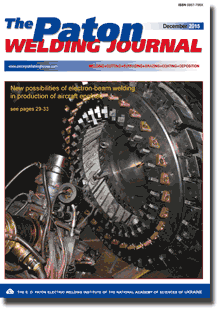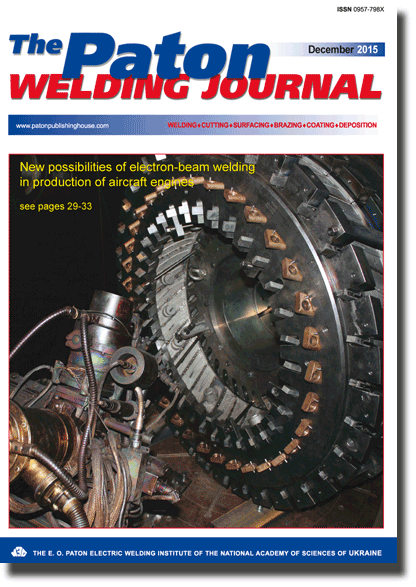| 2015 №12 (06) |
DOI of Article 10.15407/tpwj2015.12.07 |
2015 №12 (08) |

The Paton Welding Journal, 2015, #12, 34-38 pages
Development of new emission systems of electron beam guns for process operations under space conditions
Yu.V. Zubchenko And E.G. Ternovoj
E.O. Paton Electric Welding Institute, NASU. 11 Bozhenko Str., 03680, Kiev, Ukraine. E-mail: office@paton.kiev.ua
Abstract
Development of a new system, in contrast to diode emission systems with filamentary cathode being earlier applied in space guns, is based on triode emission system with cathode preheating by electron bombardment. New emission system is designed using a procedure based on simultaneous solution of problems of analysis and synthesis applying an apparatus for trajectory analysis of electron beams. The proposed emission system is designed in two variants, i.e. manual and automated types of electron beam tools. An electron beam with phase characteristic close to linear one is formed in each of calculated variants, that provides for high specific power of the beam in place of welding (to 9 kW/mm2) at total beam capacity to 2.5 kW and, as a result, allows carrying out welding and cutting of aluminum and titanium alloys, as well as stainless steels, of up to 5 mm thickness in continuous and pulsed modes under open space conditions. 10 Ref., 1 Table, 7 Figures.
Keywords: emission system, electron beam, triode system, crossover, focal plane, trajectory analysis, perveance, operating distance, manual and automated tool, welding, cutting, brazing, heating, aluminum and titanium alloys, stainless steels
Received: 16.04.15
Published: 21.01.16
References
- Ternovoj, E.G., Shulym, V.F., Lankin, Yu.N. (2013) Repair of fragments of International Space Station using electron beam welding. In: Abstr. of Int. Conf. on Welding and Related Technologies: Present and Future. Kiev: PWI.
- Paton, B.E., Kubasov, V.N. (1970) Experiment on welding of metals in space. Avtomatich. Svarka, 5, 7-12.
- Paton, B.E., Nazarenko, O.K., Chalov, V.I. et al. (1971) Specifics of equipment and technologies of electron beam welding and cutting under space conditions. Ibid., 3, 3-8.
- (2000) Space: Technologies, materials science, structures: Coll. Ed. by B.E. Paton. Kiev: PWI.
- Bondarev, A.A., Ternovoj, E.G. (2010) Features of weld formation and properties of aluminium and magnesium alloy joints under simulated space conditions. The Paton Welding J., 11, 16-20.
- Langmuir, D.B. (1973) Theoretical limitations of cathode-ray tubes. In: Proc. of IRE, 25, 977-991. https://doi.org/10.1109/JRPROC.1937.228419
- Gorbenko, N.I., Iliin, V.P., Popova, G.S. et al. (1979) Program package ERA for automation of electron-optical calculations. In: Numerical methods of solution of electron optics problems, 31-60. Novosibirsk.
- Molokovsky, S.I., Sushkov, A.D. (1972) Intensive and ion beams. Leningrad: Energiya.
- Molokovsky, S.I., Akopiants, K.S., Zubchenko, Yu.V. et al. (1979) Effect of nonlinearity of phase characteristic on focusing of electron beam in welding guns. Avtomatich. Svarka, 9, 14-17.
- Akopiants, K.S., Zubchenko, Yu.V. (1979) Method of calculation of electron-optical system of welding gun. Ibid., 11, 33-36.
Suggested Citation
Yu.V. Zubchenko And E.G. Ternovoj (2015) Development of new emission systems of electron beam guns for process operations under space conditions. The Paton Welding J., 12, 34-38.The cost of subscription/purchase order journals or individual articles
| Journal/Currency | Annual Set | 1 issue printed |
1 issue |
one article |
| TPWJ/USD | 384 $ | 32 $ | 26 $ | 13 $ |
| TPWJ/EUR | 348 € | 29 € | 24 € | 12 € |
| TPWJ/UAH | 7200 UAH | 600 UAH | 600 UAH | 280 UAH |
| AS/UAH | 1800 UAH | 300 UAH | 300 UAH | 150 UAH |
| AS/USD | 192 $ | 32 $ | 26 $ | 13 $ |
| AS/EUR | 180 € | 30 € | 25 € | 12 € |
| SEM/UAH | 1200 UAH | 300 UAH | 300 UAH | 150 UAH |
| SEM/USD | 128 $ | 32 $ | 26 $ | 13 $ |
| SEM/EUR | 120 € | 30 € | 25 € | 12 € |
| TDNK/UAH | 1200 UAH | 300 UAH | 300 UAH | 150 UAH |
| TDNK/USD | 128 $ | 32 $ | 26 $ | 13 $ |
| TDNK/EUR | 120 € | 30 € | 25 € | 15 € |
AS = «Automatic Welding» - 6 issues per year;
TPWJ = «PATON WELDING JOURNAL» - 12 issues per year;
SEM = «Electrometallurgy Today» - 4 issues per year;
TDNK = «Technical Diagnostics and Non-Destructive Testing» - 4 issues per year.


